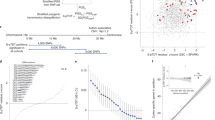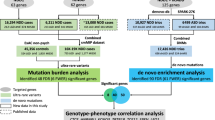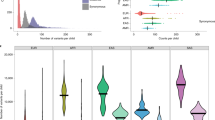Abstract
Chromosome 17q11-q21 is a region of the genome likely to harbor susceptibility to autism (MIM(209850)) based on earlier evidence of linkage to the disorder. This linkage is specific to multiplex pedigrees containing only male probands (MO) within the Autism Genetic Resource Exchange (AGRE). Earlier, Stone et al.1 completed a high-density single nucleotide polymorphism association study of 13.7 Mb within this interval, but common variant association was not sufficient to account for the linkage signal. Here, we extend this single nucleotide polymorphism-based association study to complete the coverage of the two-LOD support interval around the chromosome 17q linkage peak by testing the majority of common alleles in 284 MO trios. Markers within an interval containing the gene, CACNA1G, were found to be associated with Autism Spectrum Disorder at a locally significant level (P=1.9 × 10−5). While establishing CACNA1G as a novel candidate gene for autism, these alleles do not contribute a sufficient genetic effect to explain the observed linkage, indicating that there is substantial genetic heterogeneity despite the clear linkage signal. The region thus likely harbors a combination of multiple common and rare alleles contributing to the genetic risk. These data, along with earlier studies of chromosomes 5 and 7q3, suggest few if any major common risk alleles account for Autism Spectrum Disorder risk under major linkage peaks in the AGRE sample. This provides important evidence for strategies to identify Autism Spectrum Disorder genes, suggesting that they should focus on identifying rare variants and common variants of small effect.
This is a preview of subscription content, access via your institution
Access options
Subscribe to this journal
Receive 12 print issues and online access
$259.00 per year
only $21.58 per issue
Buy this article
- Purchase on Springer Link
- Instant access to full article PDF
Prices may be subject to local taxes which are calculated during checkout




Similar content being viewed by others
References
Stone J, Merriman B, Cantor R, Geschwind D, Nelson S . High density SNP association study of a major autism linkage region on chromosome 17. Hum Mol Genet 2007; 16: 704–715.
Bailey A, Le Couteur A, Gottesman I, Bolton P, Simonoff E, Yuzda E et al. Autism as a strongly genetic disorder: evidence from a British twin study. Psychol Med 1995; 25: 63–77.
Ritvo E, Freeman B, Mason-Brothers A, Mo A, Ritvo A . Concordance for the syndrome of autism in 40 pairs of afflicted twins. Am J Psychiatry 1985; 142: 74–77.
Risch N . Linkage strategies for genetically complex traits. I. Multilocus models. Am J Hum Genet 1990; 46: 222–228.
Risch N, Spiker D, Lotspeich L, Nouri N, Hinds D, Hallmayer J et al. A genomic screen of autism: evidence for a multilocus etiology. Am J Hum Genet 1999; 65: 493–507.
Chakrabarti S, Fombonne E . Pervasive developmental disorders in preschool children: confirmation of high prevalence. Am J Psychiatry 2005; 162: 1133–1141.
Rice C . Prevalence of autism spectrum disorders--autism and developmental disabilities monitoring network, six sites, United States, 2000. MMWR Surveill Summ 2007; 56: 1–11.
Wassink T, Brzustowicz L, Bartlett C, Szatmari P . The search for autism disease genes. Ment Retard Dev Disabil Res Rev 2004; 10: 272–283.
Cantor R, Kono N, Duvall J, Alvarez-Retuerto A, Stone J, Alarcón M et al. Replication of autism linkage: fine-mapping peak at 17q21. Am J Hum Genet 2005; 76: 1050–1056.
Yonan A, Alarcón M, Cheng R, Magnusson P, Spence S, Palmer A et al. A genomewide screen of 345 families for autism-susceptibility loci. Am J Hum Genet 2003; 73: 886–897.
Stone J, Merriman B, Cantor R, Yonan A, Gilliam T, Geschwind D et al. Evidence for sex-specific risk alleles in autism spectrum disorder. Am J Hum Genet 2004; 75: 1117–1123.
Geschwind D, Sowinski J, Lord C, Iversen P, Shestack J, Jones P et al. The autism genetic resource exchange: a resource for the study of autism and related neuropsychiatric conditions. Am J Hum Genet 2001; 69: 463–466.
Liu J, Nyholt D, Magnussen P, Parano E, Pavone P, Geschwind D et al. A genomewide screen for autism susceptibility loci. Am J Hum Genet 2001; 69: 327–340.
Ozgen H, Hop J, Hox J, Beemer F, van Engeland H . Minor physical anomalies in autism: a meta-analysis. Mol Psychiatry 2008; e-pub ahead of print.
Hu-Lince D, Craig D, Huentelman M, Stephan D . The Autism Genome Project: goals and strategies. Am J Pharmacogenomics 2005; 5: 233–246.
Pritchard J, Stephens M, Donnelly P . Inference of population structure using multilocus genotype data. Genetics 2000; 155: 945–959.
Lord C, Rutter M, Le Couteur A . Autism Diagnostic Interview-Revised: a revised version of a diagnostic interview for caregivers of individuals with possible pervasive developmental disorders. J Autism Dev Disord 1994; 24: 659–685.
Lord C, Rutter M, Goode S, Heemsbergen J, Jordan H, Mawhood L et al. Autism diagnostic observation schedule: a standardized observation of communicative and social behavior. J Autism Dev Disord 1989; 19: 185–212.
de Bakker P, Yelensky R, Pe'er I, Gabriel S, Daly M, Altshuler D . Efficiency and power in genetic association studies. Nat Genet 2005; 37: 1217–1223.
Oliphant A, Barker D, Stuelpnagel J, Chee M . BeadArray technology: enabling an accurate, cost-effective approach to high-throughput genotyping. Biotechniques 2002; June(Suppl): 56–58, 60–51.
Purcell S, Neale B, Todd-Brown K, Thomas L, Ferreira M, Bender D et al. PLINK: a tool set for whole-genome association and population-based linkage analyses. Am J Hum Genet 2007; 81: 559–575.
Barrett J, Fry B, Maller J, Daly M . Haploview: analysis and visualization of LD and haplotype maps. Bioinformatics 2005; 21: 263–265.
Iafrate A, Feuk L, Rivera M, Listewnik M, Donahoe P, Qi Y et al. Detection of large-scale variation in the human genome. Nat Genet 2004; 36: 949–951.
Ma D, Cuccaro M, Jaworski J, Haynes C, Stephan D, Parod J et al. Dissecting the locus heterogeneity of autism: significant linkage to chromosome 12q14. Mol Psychiatry 2007; 12: 376–384.
Szatmari P . Heterogeneity and the genetics of autism. J Psychiatry Neurosci 1999; 24: 159–165.
Alarcón M, Yonan A, Gilliam T, Cantor R, Geschwind D . Quantitative genome scan and ordered-subsets analysis of autism endophenotypes support language QTLs. Mol Psychiatry 2005; 10: 747–757.
Botstein D, Risch N . Discovering genotypes underlying human phenotypes: past successes for Mendelian disease, future approaches for complex disease. Nat Genet 2003; 33: 228–237.
Carlson C, Eberle M, Kruglyak L, Nickerson D . Mapping complex disease loci in whole-genome association studies. Nature 2004; 429: 446–452.
Pruitt K, Tatusova T, Maglott D . NCBI Reference Sequence (RefSeq): a curated non-redundant sequence database of genomes, transcripts and proteins. Nucleic Acids Res 2005; 33: D501–D504.
Blanks A, Zhao Z, Shmygol A, Bru-Mercier G, Astle S, Thornton S . Characterization of the molecular and electrophysiological properties of the T-type calcium channel in human myometrium. J Physiol 2007; 581: 915–926.
Perez-Reyes E, Lory P . Molecular biology of T-type calcium channels. CNS Neurol Disord Drug Targets 2006; 5: 605–609.
Singh B, Monteil A, Bidaud I, Sugimoto Y, Suzuki T, Hamano S et al. Mutational analysis of CACNA1G in idiopathic generalized epilepsy. Mutation in brief . Online. Hum Mutat 2007; 28: 524–525.
Krey J, Dolmetsch R . Molecular mechanisms of autism: a possible role for Ca2+ signaling. Curr Opin Neurobiol 2007; 17: 112–119.
Palmieri L, Papaleo V, Porcelli V, Scarcia P, Gaita L, Sacco R et al. Altered calcium homeostasis in autism-spectrum disorders: evidence from biochemical and genetic studies of the mitochondrial aspartate/glutamate carrier AGC1. Mol Psychiatry 2008; e-pub ahead of print.
Hemara-Wahanui A, Berjukow S, Hope C, Dearden P, Wu S, Wilson-Wheeler J et al. A CACNA1F mutation identified in an X-linked retinal disorder shifts the voltage dependence of Cav1 4 channel activation. Proc Natl Acad Sci USA 2005; 102: 7553–7558.
Splawski I, Timothy K, Sharpe L, Decher N, Kumar P, Bloise R et al. Ca(V)1.2 calcium channel dysfunction causes a multisystem disorder including arrhythmia and autism. Cell 2004; 119: 19–31.
Splawski I, Yoo D, Stotz S, Cherry A, Clapham D, Keating M . CACNA1H mutations in autism spectrum disorders. J Biol Chem 2006; 281: 22085–22091.
Qiu J, Bosch M, Jamali K, Xue C, Kelly M, Rønnekleiv O . Estrogen upregulates T-type calcium channels in the hypothalamus and pituitary. J Neurosci 2006; 26: 11072–11082.
Acknowledgements
We thank Dr Vlad Kustanovich at AGRE and Dr Sarah Spence formerly at AGRE for their support and guidance. We gratefully acknowledge the resources provided by the Autism Genetic Resource Exchange (AGRE) Consortium and the participating AGRE families. The Autism Genetic Resource Exchange is a program of Autism Speaks and is supported, in part, by Grant 1U24MH081810 from the National Institute of Mental Health to Clara M Lajonchere (PI). AGRE Illumina HumanHap550 data were generated at the Children's Hospital of Philadelphia and the University of Pennsylvania through collaboration between the laboratories of Dr Hakon Hakonarson and Dr Maja Bucan. These data were provided to AGRE by Drs Bucan and Hakonarson. We thank them for their contribution. The Autism Genetic Resource Exchange is a program of Autism Speaks and is supported, in part, by Grant MH64547 from the National Institute of Mental Health to Daniel H Geschwind (PI). This work was supported by MH64547, NS052108 and a grant from Cure Autism Now.
Author information
Authors and Affiliations
Corresponding author
Ethics declarations
Competing interests
The authors declare no conflict of interest.
Additional information
Supplementary Information accompanies the paper on the Molecular Psychiatry website
Supplementary information
Rights and permissions
About this article
Cite this article
Strom, S., Stone, J., ten Bosch, J. et al. High-density SNP association study of the 17q21 chromosomal region linked to autism identifies CACNA1G as a novel candidate gene. Mol Psychiatry 15, 996–1005 (2010). https://doi.org/10.1038/mp.2009.41
Received:
Revised:
Accepted:
Published:
Issue Date:
DOI: https://doi.org/10.1038/mp.2009.41
Keywords
This article is cited by
-
A systematic review of common genetic variation and biological pathways in autism spectrum disorder
BMC Neuroscience (2021)
-
Genetic associations between voltage-gated calcium channels and autism spectrum disorder: a systematic review
Molecular Brain (2020)
-
Neuronal Cav3 channelopathies: recent progress and perspectives
Pflügers Archiv - European Journal of Physiology (2020)
-
Bio-collections in autism research
Molecular Autism (2017)
-
Cerebellar Purkinje cell p75 neurotrophin receptor and autistic behavior
Translational Psychiatry (2014)



